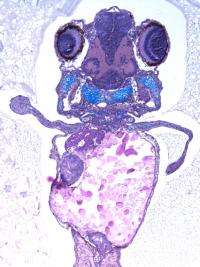From fish to man: Research reveals how fins became legs

Vertebrates' transition to living on land, instead of only in water, represented a major event in the history of life. Now, researchers reporting in the December issue of the journal Developmental Cell provide new evidence that the development of hands and feet occurred through the gain of new DNA elements that activate particular genes.
"First, and foremost, this finding helps us to understand the power that the modification of gene expression has on shaping our bodies," says Dr. José Luis Gómez-Skarmeta of the CSIC-Universidad Pablo de Olavide-Junta de Andalucía, in Seville, Spain. "Second, many genetic diseases are associated with a 'misshaping' of our organs during development. In the case of genes involved in limb formation, their abnormal function is associated with diseases such as synpolydactyly and hand-foot-genital syndrome."
In order to understand how fins may have evolved into limbs, researchers led by Dr. Gómez-Skarmeta and his colleague Dr. Fernando Casares at the same institute introduced extra Hoxd13, a gene known to play a role in distinguishing body parts, at the tip of a zebrafish embryo's fin. Surprisingly, this led to the generation of new cartilage tissue and the reduction of fin tissue—changes that strikingly recapitulate key aspects of land-animal limb development. The researchers wondered whether novel Hoxd13 control elements may have increased Hoxd13 gene expression in the past to cause similar effects during limb evolution. They turned to a DNA control element that is known to regulate the activation of Hoxd13 in mouse embryonic limbs and that is absent in fish.
"We found that in the zebrafish, the mouse Hoxd13 control element was capable of driving gene expression in the distal fin rudiment. This result indicates that molecular machinery capable of activating this control element was also present in the last common ancestor of finned and legged animals and is proven by its remnants in zebrafish," says Dr. Casares.
More information: Freitas et al.: "Hoxd13 contribution to the evolution of vertebrate appendages." DOI: 10.1016/j.devcel.2012.10.015
Journal information: Developmental Cell
Provided by Cell Press



















